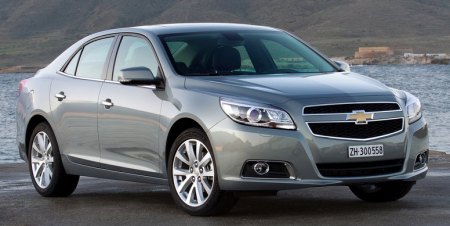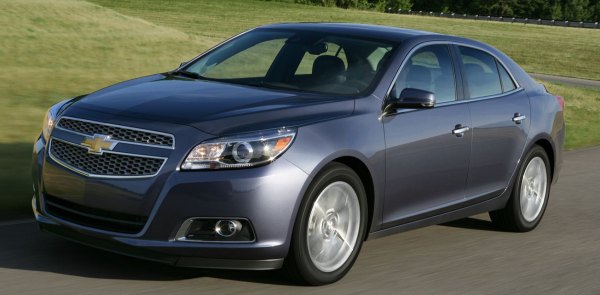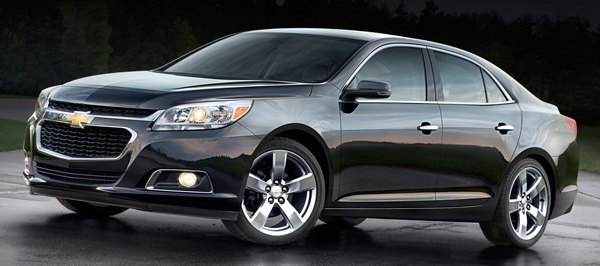|
|
|
| Published
on 15
Apr
2012 |
All rights reserved.
|
|
|
 |
In
the past 15 years,
Chevrolet Malibu has been Detroit's answer to Toyota Camry and Honda
Accord. In good years, it could sell 200,000 cars a year in
the US market, or half the number of the class leader. That
sounds not bad, but when the car got old its sales could drop to only
120,000 units – despite of heavy discounts – which was far from
acceptable.
When Bob Lutz became the Vice Chairman of GM, overseeing product
development, he pointed out its problems quickly – it looked dull, it
drove badly and its quality sucked! Worse still, the problems were not
one-off. They were caused by the bureaucratic decision making process
of the company. Most head-turning designs and edge-cutting engineering
solutions were likely to get filtered by bean-counter managers in the
name of "too risky" or "too costly". Over time, designers and engineers
lost the sense of creativity and the motivation to pursue excellence.
Lutz rolled over the old practices, questioned his people, challenged
their preconceptions and asked them to refocus on what customers really
desired – the looks, quality interior, refinement and performance. The
result was a much acclaimed duo, the 2006
Saturn Aura and 2007 Chevrolet
Malibu. Both won the North American Car of the Year award.
I admired the outgoing Malibu very much. Not only it established a new
design language for modern Chevrolets, but it was very well engineered.
When it was new, it achieved a refinement beyond the level of its
Japanese rivals. Its ride and handling was one of the best in the
class, unexpectedly. It also got a modern Holden Alloytec V6 and
6-speed automatic tranny. No wonder it was well received by the market.
Although domestic sales
were initially hit by the global credit crunch and the bankruptcy
of GM, it
recovered quickly and eventually
peaked at 200,000 units in its final year (2011), showing a strength
rarely seen on GM cars. The car-buying public rewarded its vast
improvement.
Considering
its robust sales, the outgoing Malibu could easily carry on
for two more years. However, GM CEO Dan Ankerson had a more ambitious
plan for the next generation Malibu: it will be upgraded from a
domestic product to a global product, feeding nearly 100 countries on 6
continents, in particular China, South Korea (where it will replace
Daewoo Tosca) and Australia (where it will be sold with Holden badge).
He could not wait any longer to realize the plan, so he pushed forward
its development. In October 2011, the first new Malibu was built at the
ex-Daewoo plant in Korea. By the year end, production kicked off in
China at the GM-SAIC joint-venture plant. US production and sales
joined in spring 2012, allowing it to beat the next generation Ford
Fusion, Honda Accord and Nissan Altima to the market. On the flipside,
the aggressive launch schedule caused some sacrifices in the
development program. The original plan was to launch the car with a
range of new engines, including a 2.5-liter DI and 2.0 DI
turbo, so that it will be competitive against the new Toyota Camry from
the outset. However, as these engines are still under development at
the powertrain division, early production cars have to carry over the
old car's 2.4-liter mild-hybrid (eAssist) engine,
which is obviously not the best engine of the class.
Another
change
showing its global vision is the underpinning. The
outgoing Malibu was built on the long-wheelbase (2852 mm) version of
Epsilon platform in order to please American families. The new car
moves to the standard wheelbase (2737 mm) Epsilon II platform of Opel
Insignia / Buick Regal in order to boost economy of scale, as the Buick
is already being produced in China and the US. It goes without saying
that the reduced wheelbase has an adverse effect on rear seat legroom,
as we shall see later. Nevertheless, the shrinkage should free up space
for the forthcoming Chevrolet Impala. On the outside, the new Malibu is
actually no smaller than the old car. Its overall length is reduced by
merely 12 mm, while width and height are increased by 70 mm and 15 mm
respectively. Its front and rear track have been stretched by 64 and 50
mm respectively. It also gets slightly heavier than the car it replaces,
thanks to a 20 percent boost in chassis rigidity, more NVH suppression
and relatively lack of lightweight engineering concern. Compare with
the equivalent Toyota Camry, a 2.4-liter eAssist Malibu carries 200 kg
more! That's why it takes as long as 8.7 seconds to go from rest to 60
mph, a full second longer than its rival.
Space and weight efficiency aside, the new packaging is excellent. No
matter exterior or interior, the car looks stylish and well put
together. Its exterior design is less conservative than its Japanese
rivals but without going to the extreme like Hyundai Sonata, so it
should please the majority of families. The smartest features are the
quad-rectangular taillights, which have some traces of Camaro, though
the
outer two's ice block effect is by all means original. They add
sparkles to the
otherwise predictable design. In the cabin, the dashboard employs
twin-cockpit theme to enhance style and sense of space. The twin-cowl
instrument is again inspired by Camaro. The center console is dominated
by a standard-fit 7-inch touch screen, which gives access to an
infotainment and wireless connectivity system called MyLink. The screen
can be flipped up to reveal a storage bin. All controls are positioned
logically thus are easy to operate. Materials are generally good.
Soft-touch plastics are extensively used. While you are unlikely to
confuse the wood trim with real wood or the bezel of center console
with real metal, they don't look too disgraceful. The only quality
issue is the mismatched grain on door panels, which could have been
avoided if the development schedule was not so tight.
The driver enjoys much the same headroom and legroom as in the old car,
while the wider body contributes to 40 mm extra shoulder room. At the
back, shoulder room is increased by 80 mm, headroom gains 10 mm, but
the shorter wheelbase leads to a reduction of legroom by 18 mm. That
might sound not too bad, but one has to note that the old Malibu
was not a good example for space efficiency either. Compare with the
more remarkable Toyota Camry, the new Chevy offers 50 mm less rear
legroom and 13 mm less rear headroom. Those figures make a big
difference when a six-footer sits at the back. In short, rear
accommodation is the weak link of Malibu.
As
aforementioned, powered by the existing 2.4-liter engine, the Malibu is
slow. This engine looks state of the art on paper, with dual-variable
valve timing and direct fuel injection, but it produces a disappointing
182 hp and 172 lbft of torque. The mild-hybrid (eAssist) system offers
15 hp and 79 lbft from a boot-mounted small lithium battery, but it
mainly functions as an on-demand starter-alternator, i.e. to implement
automatic stop-start and regenerative braking. It does provide extra
juice under full-throttle acceleration, but that is limited to low rpm
for a short duration so that the peak output still comes solely from
the gasoline engine. The Malibu equipped with this engine also gets
energy-saving tires and an active front grille shutter to reduce drag
at highway speed. Speaking of drag, GM said it spent hundreds of hours
in wind tunnel to shape the car, but actually the drag coefficient is
nothing special at 0.30. Taking into account the immense weight, the
mild-hybrid car is not particularly greener than the 4-cylinder Camry
or Sonata, and trails the full-hybrid Camry by a long way. After all,
the 2.4 engine was based on an aging design. It does not have
low-friction internals and on-demand lubrication/cooling pumps like the
forthcoming 2.5-liter engine. The latter will offer a more competitive
197 horses and 191 lbft of torque when it goes on sale this summer. By
the year end, a 2.0-liter Ecotec DI turbo with 260 hp and 290 lbft will
complete the range and take the vacancy left by the outgoing 3.6 V6. GM
said it will be capable to do 0-60 in 6.3 seconds. Maybe it is not the
right time to buy the Malibu yet.
On the road, the new Malibu impresses most with its high level of
refinement. Thanks to the solid structure and generous use of NVH
suppressing materials such as laminating windscreen and windows, the
cabin is remarkably quiet. The only annoying noise comes from the
cooling fan of the boot-mounted battery, which draws air from the
cabin, but you can avoid it by opting for other engines in the future.
The ride is also quiet and composed. Its suspension tuning is softer
than Buick Regal (which is softer than the European Opel Insignia
again) but slightly firmer than Toyota Camry with standard suspension.
This mean while the ride is still highly comfortable, it controls its
body movement a bit better than its arch-rival. Its ZF power steering,
assisted with a rack-mounted electric motor, delivers better weighting,
accuracy and linearity than most rivaling systems. That said, the
Malibu does not corner as crisped as the sportier Mazda 6, VW Passat or
Ford Fusion. It rolls more and understeer earlier, feeling heavier and
more nose-led. After all, it is still very much a comfortable family
car in the first place.
Benefited by a stylish look, a modern interior and impressive running
refinement, the new Malibu should be more appealing to buyers than
ever. Nevertheless, it is still a slight disappointment considering how
accomplished the old car was. Its lack of performance and rear seat
accommodation are shortcomings that we have not expected. It might be
competitive in the segment now, but can it beat the next generation
Ford Fusion and Mazda 6 in a few months' time? I doubt.
|
Verdict:    |
| Published
on 5
Oct
2012 |
All rights reserved.
|
|
Malibu 2.0 Turbo
|
|

|
Following the industrial
trend, Chevrolet Malibu has abandoned V6 power for a turbocharged
four-cylinder engine to cut fuel consumption. The all-alloy 2.0-liter
Ecotec features direct injection and a twin-scroll turbocharger. The
latter boosts at most 1.4 bar and enables the engine to pump out a
respectable 259 horsepower – that is 13 hp short of the version
employed by Cadillac ATS, whose longitudinal mounting allows better
breathing, but it is already more than the new Ford Fusion 2.0T (240hp)
as well as the old Malibu V6 (252hp). The engine also produces 260
pound-foot of torque across a wide band, i.e. from 1700 to 5500 rpm. GM
claims 0-60 mph can be achieved in 6.3 seconds, while top speed is a
European-style 155 mph.
Enough figures. How does the engine perform in the real world? For
sure, it is a lot stronger than the existing 2.4 and 2.5-liter engines.
Given that thick torque, flexibility is not lacking. Twin-balancer
shafts keep vibration under check at most time, whereas the twin-scroll
turbo displays little lag except at very low rpm. BMW's N20 turbo is
more refined and responsive still, but as far as a mainstream brand is
concerned, the Ecotec turbo is hard to fault. The only let down is the
power tails off quickly beyond 5500 rpm, so don't expect the Malibu
Turbo to be a performance sedan. Its strength lies in flexibility
rather than outright punch. The lack of paddle shift on the automatic
tranny also discourages spirited drive.
Thanks to the Malibu's vast insulation, engine noise is low in the
cabin. The same goes for road noise. GM has barely retuned its
suspension and weighed up its steering a little, so the refined ride
remains intact. In corners, the car is composed and tidy, if not very
agile and engaging to drive. The turbo conversion has not changed the
character of Malibu. It remains a comfort-first family car. No wonder
from outside you can't spot any differences from lesser models – not
even a tiny spoiler or a turbo badge!
|
Verdict:    |
| Published
on 14
Feb
2014 |
All rights reserved.
|
|
Malibu facelift 2013
|
|

|
General Motors seems to be
totally refreshed since it emerged from bankruptcy protection. However,
it still made some bad mistakes. Chevrolet Malibu is one example.
Debuted in early 2012, the company's core mid-size sedan received a lot
of criticisms about its lack of rear seat space and mediocre
four-cylinder engines. This reflected in its sales figures, which
trailed class rivals Toyota Camry, Honda Accord, Nissan Altima and Ford
Fusion by a long way. That's why GM responded immediately and gave it
an emergency facelift by the late 2013.
The 2014 model year Malibu has a slightly revised front grille and
tail. It is not necessarily any better looking, but it does provide the
necessary differences to distinguish from the old car. More important
is the revision inside the cabin and under the bonnet. The rear seat is
given 32 mm more legroom by sculpting the front seat backs and rear
seat cushion. The extra space is welcomed, but it doesn't change the
fact that the Malibu's interior is still cramped by class standard.
Unfortunately, this problem is not going to be solved until the car is
eventually
replaced.
On the mechanical side, the 2.5-liter DI engine gets GM's first
variable valve lift mechanism, iVLC. It
uses special roller rockers to
switch between high and low-lift cam profiles. Theoretically, it should
offer a wider power band and improved low-rev torque. Somehow, its
rated
output is reduced by 1 horsepower to 196 hp, and max. torque drops by 5
pound-foot to 186. This reflects on the performance numbers tested by
Car and Driver, which are marginally slower than the old car's.
Nevertheless, it does improve EPA fuel economy from 22 to 25 mpg in
city and 34 to 36 mpg on highway, although part of the saving actually
comes from the new automatic stop-start function. Meanwhile, the
range-topping 2.0 turbo engine has its peak torque increased from 260
to 295 lbft.
At the chassis, the suspension dampers now feature rebound springs to
improve control. The electrical power steering has been recalibrated to
be weightier and more engaging. The brake pedal has also been
recalibrated. All revisions contribute to a slightly better drive.
However, overall speaking the car is still rather average.
|
Verdict:    |
|
|
|
|
|
|
|
|
|
|
Malibu 2.4 Eco
|
2012
|
| Front-engined,
FWD |
| Steel monocoque |
| Mainly steel |
| 4860 / 1855 / 1465 mm |
| 2737 mm |
Inline-4 + electric motor
|
| 2384 cc |
DOHC 16 valves, DVVT
|
| - |
| DI |
Engine: 182 hp
Motor: 15 hp
|
Engine: 172 lbft
Motor: 79 lbft
|
| 6-speed automatic |
F: strut
R: multi-link
|
| - |
225/55R17
|
1642 kg
|
131 mph (limited)
|
8.7 (c) / 8.1*
|
22.4*
|
|
Malibu
2.5
|
2012
|
| Front-engined,
FWD |
| Steel monocoque |
| Mainly steel |
| 4860 / 1855 / 1465 mm |
| 2737 mm |
Inline-4
|
| 2499 cc |
DOHC 16 valves, DVVT
|
| - |
| DI |
197 hp
|
191 lbft
|
| 6-speed automatic |
F: strut
R: multi-link
|
| - |
225/55R17
|
1610 kg
|
135 mph (est)
|
7.9 (c) / 7.7*
|
21.9*
|
|
Malibu
2.0 Turbo
|
2012
|
| Front-engined,
FWD |
| Steel monocoque |
| Mainly steel |
| 4860 / 1855 / 1462 mm |
| 2737 mm |
Inline-4
|
| 1998 cc |
DOHC 16 valves, VVT
|
| Turbo |
| DI |
259 hp
|
260 lbft
|
| 6-speed automatic |
F: strut
R: multi-link
|
| - |
235/50R18
|
1656 kg
|
155 mph (c)
|
6.3 (c) / 6.3*
|
16.7*
|
|
|
|
|
|
Performance
tested by: *C&D
|
|
|
|
|
|
|
Malibu 2.5
|
2013
|
| Front-engined,
FWD |
| Steel monocoque |
| Mainly steel |
| 4860 / 1855 / 1465 mm |
| 2737 mm |
Inline-4
|
| 2457 cc |
DOHC 16 valves, DVVT, VVL
|
| - |
| DI |
196 hp
|
186 lbft
|
| 6-speed automatic |
F: strut
R: multi-link
|
| - |
225/55R17
|
1602 kg
|
135 mph (est)
|
7.9*
|
22.1*
|
|
Malibu 2.0 Turbo
|
2013
|
| Front-engined,
FWD |
| Steel monocoque |
| Mainly steel |
| 4860 / 1855 / 1462 mm |
| 2737 mm |
Inline-4
|
| 1998 cc |
DOHC 16 valves, VVT
|
| Turbo |
| DI |
259 hp
|
295 lbft
|
| 6-speed automatic |
F: strut
R: multi-link
|
| - |
235/50R18
|
1656 kg
|
155 mph (c)
|
6.2*
|
15.9*
|
|
|
|
|
|
|
| Performance
tested by: *C&D |
|
|
|
|
|
|
|
|
Copyright©
1997-2014
by Mark Wan @ AutoZine
|
|